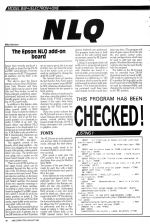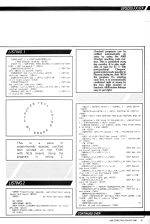
A&B Computing
 1st January 1986
1st January 1986
Categories: Review: Peripheral
Author: Mike Harrison
Publisher: Epson
Machine: BBC Model B
Published in A&B Computing 3.01
The Epson NLQ add-on board
NLQ
Epson have recently produced a NLQ add-on board for the FX, JX and RX+ series printers. There are two versions: the 8177 has a parallel interface, and the 8647 is the serial version.
This add-on gives the Epson printers a choice of two NLQ character fonts (Roman and Sans Serif), which may be used in both Elite and Pica modes, as well as being enlarged, underlined, super/subscripted, italicised and proportional paces, giving a wide variety of NLQ print styles.
In addition to this feature, extra facilities are provided for use in either normal (draft) or NLQ mode. These include the ability to set character spacing to any number of 'dots', and to set the horizontal position of a character to within 1/120th of an inch. The board allows user-defined NLQ characters to be downloaded in a similar way to normal draft character. A 2K buffer is also provided, or 6K if downloaded characters are not required. (This may be extended to 8/12K - see later.)
The upgrade consists of two boards, which plug together - the lower one plugging into the main board of the printer, making installation very easy. The printer lead now plugs into a socket on the lower board instead of the one on the main printer board.
There is a set of DIP switches on the upper board, which can be operated through the flap on the top of the FX printers along with the ones on the main board. There are also two switches on the lower board, these being the 'Auto Feed' and 'Select' switches. The manual shows two opposite meanings to the positions of these switches, according to which version of the board is supplied. For BBC operation, switch 1 should be set to the same position as switch 2. The switches on the top set NLQ/draft mode, input buffer mode and various other odds and ends.
NLQ cannot be accessed by front panel controls as they can with the the Canon and LX printers, but as the DIP switches on the FX printers are so easy to get at, this is no real problem (you can leave the screw out of the switch cover, so it can easily be unclipped to change the draft/NLQ DIP switch).
The manual does not mention the fact that the 'Auto Feed' switch on the main printer board must be off, otherwise a linefeed is performed between the two passes in NLQ printing.
Another point not mentioned is that when using the printer in hex dump mode, if NLQ is selected, instead if the input data being dumped, the graphics codes generated by the NLQ board are dumped!
These two points indicate that the NLQ board acts as a 'pre-processor' between the micro and the printer, normal printing being passed straight through, and NLQ being intercepted and converted to graphics codes.
Fonts
The NLQ fonts are quite pleasant, and are less 'dotty' in emphasised mode, although the inter-character spacing really needs to be increased slightly to avoid characters touching.
Print speed is quite slow (32 CPS quoted), but is still a great deal faster than using the Watford NLQ ROM. Two passes of the print head are made for each line, with a slight vertical shift between each pass to fill in the gaps.
Some options are only available in proportional-spaced mode, in particular the Sans Serif font, which I prefer to the Roman one. Italics are also only available in Relational mode. Subscripted LO provides a very nice small print for labels etc., when used in conjunction with 1/8th line spacing.
The ability to accurately specify the horizontal position of a character allows true X-Y positioning to be performed, and this is illustrated in Listing 1. Only use this routine with friction feed, or the FX80 internal tractor feed, as reverse linefeeds are performed. The program works best in draft mode, as the extra vertical paper movements caused by NLQ printing impair accuracy.
Listing 2 is a program which will justify text in proportional-spaced mode in either font. The widths of each character are stored in a look-up table, so the actual length of a word can be calculated. the ",," character is re-defined as a 1/120 inch space, which is used for padding the words to achieve right-justification. (The horizontal positioning command could have been used instead, but this would have been very slow.) The program will strip all spare spaces from the text file, and ignore control codes, except carriage returns, which may be used to split text into paragraphs. Wordwise files without any control codes may be used directly with this program.
The buffer on the NLQ board may be extended from 2K/6K (download used/not used) to 8K/12K simply by replacing the 6116 IC in position 5A (top right) on the lower board with a 6264 RAM chip (as used for sideways RAM), and changing the jumper link (J1/J2) to the '8K' position.
This article was converted to a web page from the following pages of A&B Computing 3.01.




